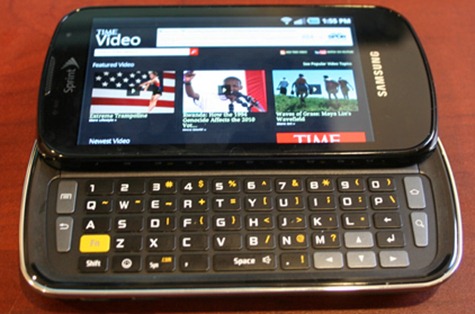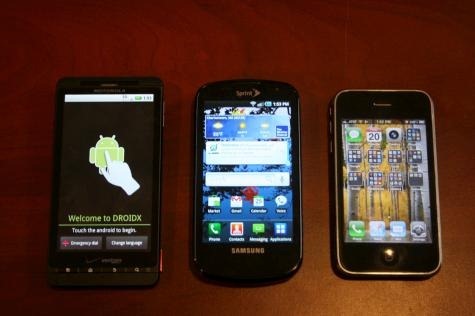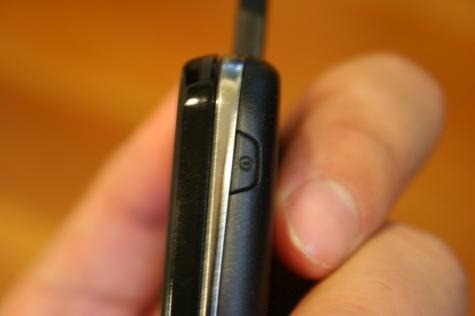The Samsung Epic 4G marks Sprint’s second 4G-capable Android handset and the first one with a slide-out hardware keyboard. The phone features a 4-inch, 800×480 Super AMOLED screen, Android 2.1, rear-facing 5-megapixel camera with LED flash, front-facing VGA camera, 1GHz processor, and 16GB of storage which is expandable to 32GB via microSD cards.
It’s available starting today, with a price of $250 after a $100 mail-in rebate and two-year Sprint contract.
Things I Like
The phone itself is built solidly, inside and out. It’s large enough to feel substantial in the hand but not too large that it doesn’t easily fit into a pocket. I expected it to be a bit thicker and clunkier, but it’s a very thoughtfully designed phone. The spring-loaded keyboard slides in and out of place with a satisfying “thud” each time without feeling rickety.

From a usability standpoint, the fast processor and ample memory make for a very fluid and cohesive interface. Everything just works. There are few, if any, slowdowns, hangs, or crashes. Programs launch and close quickly, the screen is very responsive to touch, and the fast data connection makes the Epic feel more like a little handheld computer at times.
The screen is bright and saturated, and thanks to the industrial process that Samsung uses to make these Super AMOLED panels, the screen feels as though it’s part of the top of the phone instead of a piece of glass with a screen underneath it like you’d find on most other phones. Aside from navigating the interface and surfing the web, watching movies on this thing is incredible—even ones with resolutions lower than 800×480.
As a phone, call quality is slightly above average in the Boston area but there’s just a single microphone, which means no fancy noise cancellation magic like you’d find on other recently-released smartphones. The speakerphone is plenty loud, but callers on the other end sound tinny and have a tendency to pop a bit at higher volumes.
If you’re considering this device solely to make phone calls, you can do better. If you’re looking for a high-speed Android device that happens to make decent phone calls, you’ve found it.
For a phone that costs $250 after a $100 mail-in rebate and requires a $10-per-month service premium for the privilege of connecting to a 4G network, you should like just about everything. And after the time I’ve spent with the Epic 4G, I came away impressed overall. Had I spent my own money on the phone, I would have generally felt like I’d gotten what I paid for.

All the core features that a smartphone should have—web, e-mail, music, movies, games, apps—work well here. Samsung’s done a nice job, overall. As one of the most expensive phones on the market today, the Epic 4G should leave its owners little to complain about. It does that, for the most part, but that’s not to say there aren’t any drawbacks.
Things I Don’t Like
For me, the fact that the four main Android buttons (Home, Search, Back, and Menu) aren’t actual, physical buttons was the main cause of most of my frustrations, believe it or not.

When the screen times out, the only way to get it to wake back up is to either slide open the keyboard or press the awkwardly placed power button located in the upper right-hand corner underneath the chrome bezel separating the screen from the keyboard. This may all sound minor, but consider how many times per day you need to wake your phone up when the screen’s gone dark.

As for the customized TouchWiz user interface that Samsung has implemented on top of Android, it’s a mixed bag depending on whether or not you’ve used Android before. Android veterans may not care for it, while those new to Android will likely appreciate its simplicity. It’s very iPhone-like.
The main problem with this particular implementation of TouchWiz is that the four main dock icons can’t be changed, even though you have the option to customize them on the other Samsung Galaxy S phones. As a result, I’m stuck with Phone, Contacts, Messaging, and Applications icons. I rarely use the first three, and would much rather have quick access to my Gmail shortcut, my Google Voice shortcut, and a web browser shortcut.
Somewhere in the Middle
The five-megapixel camera takes above average photos and captures above average HD video, with video capture being the more impressive of the two. You could conceivably use this phone to replace a dedicated pocket camcorder, but the battery would wear down pretty quickly. The front-facing VGA camera works okay for video chatting via Fring and live video via Qik, but the overall quality depends highly on your connection speed and never really reaches “holy crap, that’s really good” territory. If you’re into video calling and you live in a 4G coverage area, though, the Epic’s a good choice.
Using the phone as a dedicated point and shoot camera isn’t quite as enticing, but it does just fine in a pinch if you want to quickly take a photo of something. There are an almost overwhelming number of scene modes and options, and the camera does well in natural light and macro shots, although the LED flash tends to wash out photos of anything closer than a few feet.
Full Resolution Example Photos: Outside, No Flash | Inside, No Flash | Inside, Macro, No Flash | Inside, Flash

The keyboard, while nice to have, is a bit mushy. The keys are decently spaced but there’s a bit too much vertical travel and the spacebar is too small for my liking. I have large hands, though. I actually found myself rarely using the keyboard after a couple days, as Android’s on-screen keyboard, and, in particular, Swype, have both done an excellent job at handling text input. I used to be a big hardware keyboard guy, but I’ve finally reached the point with most phones that I don’t miss one any more.
Battery life is average. You’ll be able to get an entire day of mixed use out of it, but you’ll definitely want to keep the charger nearby. The 4G data connection can be toggled on and off quickly, but leaving it on all day will drain the battery much, much faster than the 3G signal. If I were to keep using this as my regular phone, I’d be on the lookout for extended batteries just so I wouldn’t have to worry about it as much.
As a side note, I wasn’t able to fully test the 4G connection here in Boston, as it hasn’t been officially rolled out by Sprint yet. The network is live in certain pockets but I’d either frequently disconnect or experience odd speed test results. At home, for example, I get 4G upload speeds of more than 1Mbps but download speeds of only around 512kbps.
When switching to the 3G connection, I get download speeds of over 1Mbps and upload speeds of around 150kbps. In one part of the city, I was able to consistently clock 4G downloads in excess of 3Mbps. I was able to tether the phone to my laptop at those speeds and found the connection to be refreshingly fast, though it ran the battery down entirely within a few hours.
So I can’t really comment thoroughly on the 4G connection except to say that if you live in an actual 4G coverage area, you likely won’t be disappointed in the speeds you’re able to achieve. Sprint promises average download speeds between 3Mbps and 6Mbps, which is on par with most first and second tier broadband plans offered by various at-home providers.
Conclusion
The Samsung Epic 4G is a solid phone overall. It’s a good showcase of Android’s capabilities and makes a great addition to Sprint’s handset lineup. If your requirements are a 4G handset with a keyboard, this is your only option on Sprint right now but it won’t feel like a compromise at all. If you don’t care about the keyboard, the HTC Evo 4G is another solid option.
In the end, the decision to purchase this phone will likely come down to price for most people. At $250 after a $100 mail-in rebate and two-year contract, the phone isn’t cheap. Add to that the required $10-per-month premium you have to pay for the 4G connection (whether you use it or not), and the $30-per-month fee to use the phone as a Wi-Fi hotspot, and you’re looking at around $150 per month for unlimited voice minutes when the dust settles.
If the price doesn’t concern you, though, there’s a lot to like here. The little annoyances like the non-tactile Android buttons and the awkwardly-placed power button used to wake the phone out of standby are offset by the slick user experience, fast connection speeds, and gorgeous screen.
More on Techland:

